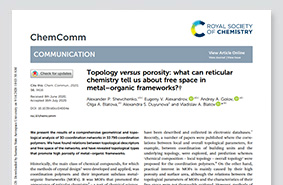 An article by SCTMS staff "Topology versus porosity: what can reticular chemistry tell us about free space in metal-organic frameworks?" was highly commended by the ChemComm editors and added to the online collection of "hot" publications and studies.
An article by SCTMS staff "Topology versus porosity: what can reticular chemistry tell us about free space in metal-organic frameworks?" was highly commended by the ChemComm editors and added to the online collection of "hot" publications and studies.This year it is the third article by our members that was included in the lists of topical articles according to the editors of the journals of the Royal Society of Chemistry. ChemComm (Chemical Communications) has been published since 1969 and is one of the most cited journals of the Royal Society of Chemistry. The topics of the researches published in ChemComm cover all aspects of chemistry. 100 issues of the journal have been published per year since 2012. The article "Topology versus porosity" is part of the two themed collections: Functional Coordination Nets (currently 30 articles in total) and Chemical Communications HOT Articles (77 articles).
All co-authors of the article are members of the research team of the SCTMS – Alexander Shevchenko, Eugeny Alexandrov, Andrey Golov, Olga Blatova, Alexandra Duyunova and Prof. Vladislav Blatov; the team represents Samara University, Samara State Technical University (Samara Polytech) and Samara branch of the Lebedev Physical Institute of the Russian Academy of Sciences (LPI RAS).
In their article, scientists for the first time studied in detail the question of whether the topology of the framework of a coordination compound can predetermine its porosity and to what extent, having considered practically all known (33 790) three-dimensional coordination polymers. On the basis of the found correlations, scientists proposed new criteria for the design of metal-organic frameworks of high porosity. The results will help experimental chemists to search new porous adsorbents and catalysts with given properties.






